Humans have explored only a small percentage of the ocean, and it remains a mysterious place. It is a place of abundance with millions of tons of seafood taken from it every year, even to the point where areas of the ocean have been depleted. The ocean is also the home to a number of innocently dangerous beasts. Unlike a few terrestrial predators, there are no ocean predators that have humans as their natural prey, but some are deadly if you come into contact with them. Here are some of the most dangerous sea creatures.
1. Jellyfish
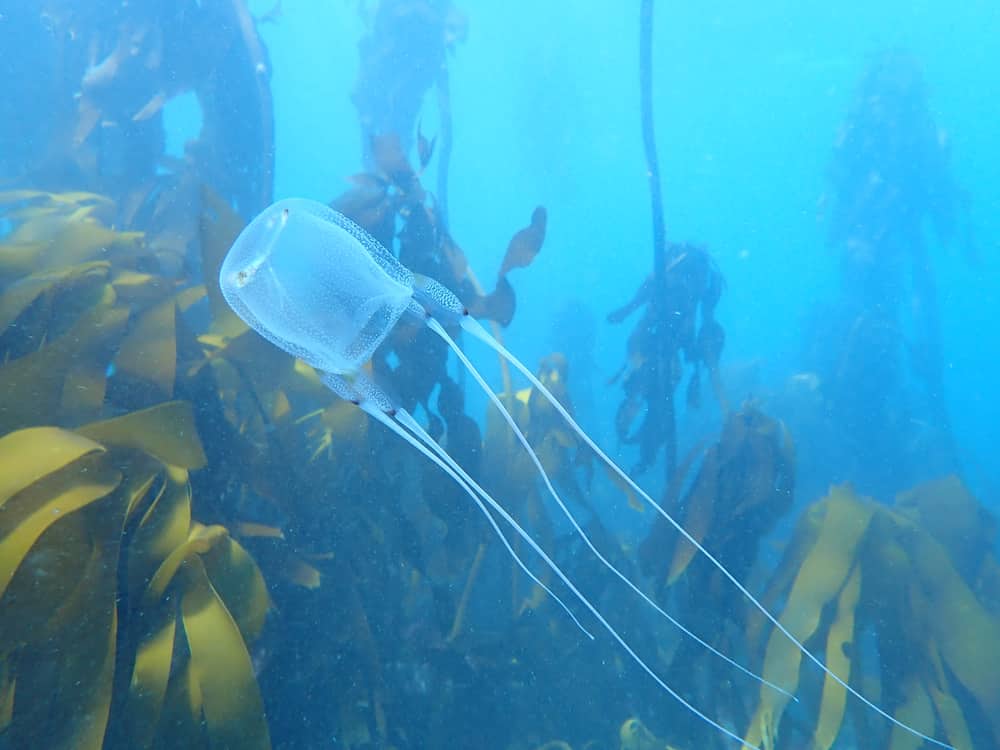
A
box jellyfish
is one of earth’s most dangerous sea creatures. Its sting can kill you.
©Katherine Wallis/Shutterstock.com
A jellyfish has no brain, and it barely has a nervous system. Some move by propelling water out of their mouths, and others move through the seas by currents and not even of their own will. A jellyfish can be as small as 1/32 of an inch to having a bell that’s 6.5 feet high and 6.5 feet around with tentacles that trail as long as 100 feet. These creatures paralyze their prey with stinging tentacles, draw it into their mouth and digest it. It’s the stinging tentacles of jellyfish that makes some of them among the most dangerous sea creatures. Here are a few of the worst:
Sea Wasp
The sting of this box jelly fish, Chironex fleckeri can cause such phantasmagorical levels of pain that the victim can go into cardiac arrest. At least 63 people have died from brushing up against this creature just in Australia. What makes things worse is that the sea wasp is diurnal, nearly transparent, and hunts for its prey in shallow water. That means you’re more likely to swim into it if you’re enjoying a day at the beach, especially a beach on the east coast of Australia. This jellyfish is also found in the Indian and Pacific Oceans.
The sea wasp’s cousin, Chiropsalmus quadrigatus also packs a horrific and sometimes fatal sting. It’s a little smaller than the sea wasp and is found in the western Atlantic Ocean as well as the Indo-Pacific.
Irukandji
The incredible pain caused by the sting of this jellyfish is astounding when you think that it’s only about an inch long. Though it used to be found only off the coast of Australia along with the box jellies, it’s now been encountered in Japan, Florida and even off the coast of Great Britain. Because it’s so tiny and nearly transparent, you’ll probably never see the jellyfish that you just swam or stepped into. The stings cause a phenomenon called Irukandji Syndrome. Symptoms are severe pain that can last for 12 hours, a feeling that you’re being burned alive, nausea and vomiting, cramps in the abdomen, arms and legs, heart problems, and the conviction that you are going to die. Fortunately, if you’re treated quickly, you probably won’t.
Fire Jellyfish
This jellyfish is also a resident of the warm waters of Queensland, Australia. It’s another the of box jellies, and though it’s one of the larger ones it’s only 4 inches long with a bell that’s 2 inches around. The good new is it’s not transparent and thus not so hard to see in the water. Its body is translucent and bright pink. Though the fire jelly can give you a hellish sting, it’s usually not life threatening.
2. Blue Ringed Octopus
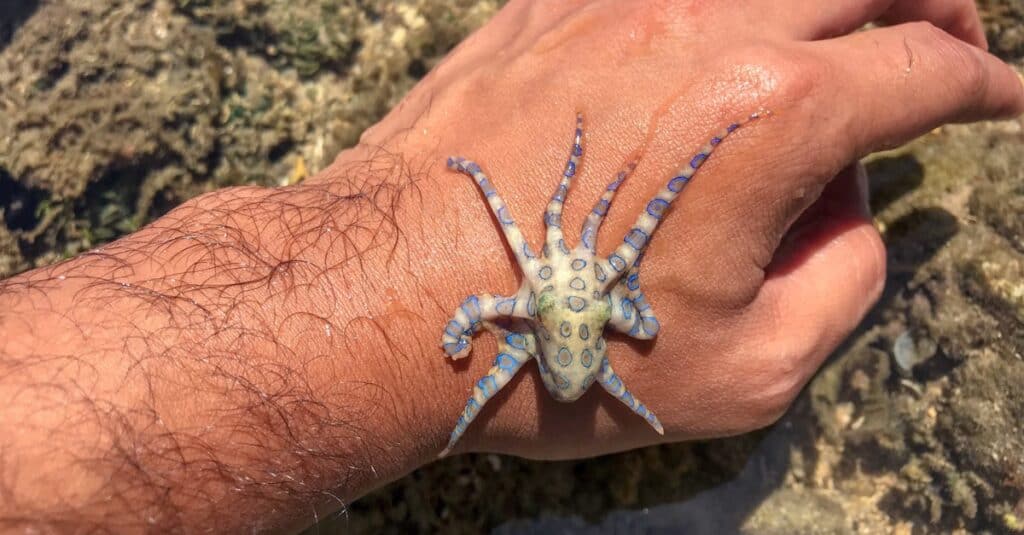
The bite of the tiny
blue-ringed octopus
can also kill you.
©Mark Anthony Sefuentes/Shutterstock.com
The four species of blue-ringed octopus are found in the coral reefs and tidal pools of the Indo-Pacific. These octopuses are only 5 to 8 inches long, shy, secretive, with yellow skin embellished with blue and black rings. They’re also incredibly dangerous sea creatures if you handle them when they don’t want to be handled. You will be able to tell because they’ll turn brilliant yellow and their blue rings will start to flash. Their beaks are so tiny that you might not even feel the bite. But that bite can contain enough venom, largely tetrodotoxin, to finish off 26 grown human beings within the span of a few minutes.
You’ll know you’ve been bitten when you find it hard to breathe as paralysis takes control of your body. All the while, you’ll be conscious but unless someone is with you and can tell something is wrong you can’t even call for help. However, if you receive first aid right away, including being placed on a ventilator, you’ll probably survive and make a full recovery.
3. Cone Shell

Some cone snails are so venomous that they’re called “cigarette snails.” The joke is you’ll have time to smoke one cigarette before you die.
©Billy Watkins/Shutterstock.com
The shells of cone snails are very pretty, and you may be tempted to collect them. Do not. Cone snails are venomous and use a harpoon-shaped tooth to attack and envenomate their usual prey. Though not all cone snails are venomous enough to injure humans, there are many that are. There have been at least 30 people killed after they handled some of these snails. Scuba divers are not immune because the snail’s tongue is so sharp it can pierce a wetsuit.
These dangerous sea creatures live in the warm, shallow water in the Pacific and Indian Oceans, the Red Sea, and the Caribbean Sea. You’ll also find them off the Florida coast.
The sting of a cone snail doesn’t hurt that much because the toxin has a natural painkiller. The venom is a neurotoxin that attacks your nervous system. Eventually, you’ll notice swelling and numbness where the snail stung you. Soon, your muscles weaken, including the muscles that control your breathing. Your hearing, vision and speech are affected as well. If you’re not treated right away, you may die.
4. Scorpionfish
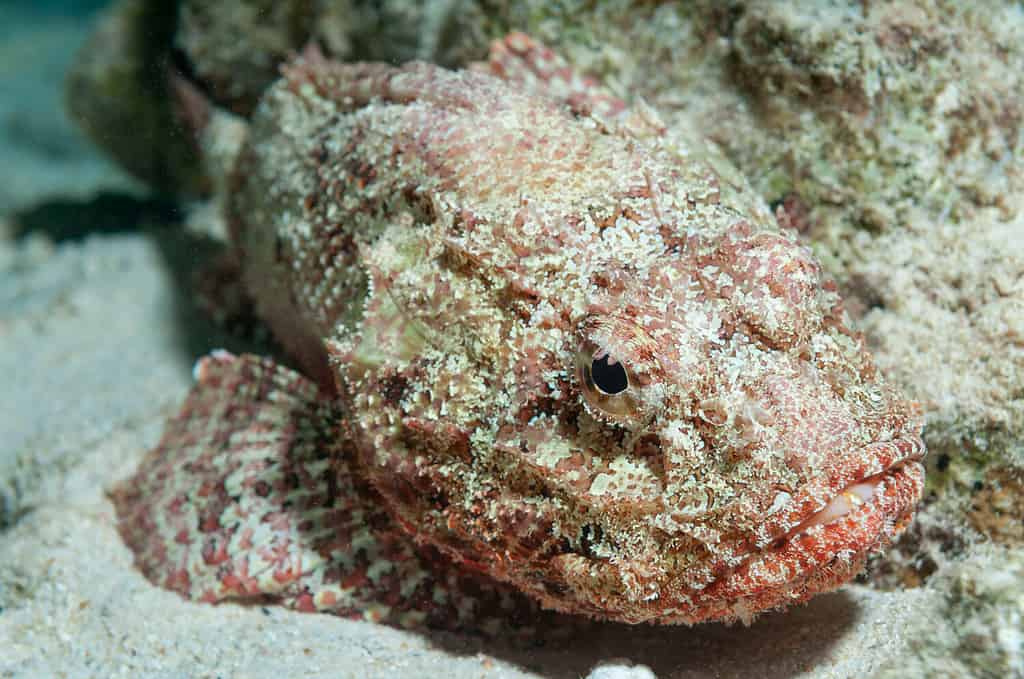
Scorpionfish are some of the most dangerous sea creatures.
©Jesus Cobaleda/Shutterstock.com
The scorpionfish comes by its name honestly, for it has spines in its anal, pelvic and dorsal fins that deliver a very nasty venom. There are hundreds of species of scorpionfish, and they’re found in the Indo-Pacific. You can find them in the depths of the ocean, but they also live in reefs in shallow water. Their coloring and patterns help to camouflage them, and a lot of people get envenomated by unwittingly stepping on one.
When you’re stung by one of these fish you feel intense pain and experience swelling right away, and the pain and swelling can encompass your arm or leg very quickly. By the way, dead scorpionfish are just as dangerous as live ones. Depending on how much venom was injected and the species of scorpionfish, you may also experience blistering, heart problems, crashing blood pressure, difficulty in breathing, abdominal cramps, nausea and vomiting, or fainting. The good news is you should recover if you receive help right away.
5. Sharks

They really aren’t out to get you, but if a shark mistakes you for a seal or other prey, it may be unfortunate.
©Sergey Uryadnikov/Shutterstock.com
Sharks have been around for hundreds of millions of years, and there are and were over 500 species in 13 orders, some of which are now extinct. Most of them, it must be said, do not attack and eat humans. Even sharks who do eat humans do so rarely, as humans are not their natural prey. Between 1958 and 2023 there were 2,900 shark attacks that were confirmed and unprovoked, and 633 of them were fatal. Most of the attacks happened off the coasts of the United States, though only 37 were fatal out of 1,106. The country with the largest number of shark attack deaths is Australia. Out of 647 attacks, 261 people died. Sharks to be respectful of if you’re in the ocean are:
- Great white shark
- Tiger shark
- Bull shark
- Oceanic whitetip shark
Interestingly, the oceanic whitetip shark doesn’t go after swimmers and divers as much as it seems to go after castaways. This shark is notorious for gathering in large numbers to feast on the survivors of shipwrecks. The late marine researcher Jacques Cousteau declared that the whitetip was the most dangerous shark in the sea.
6. Barracudas
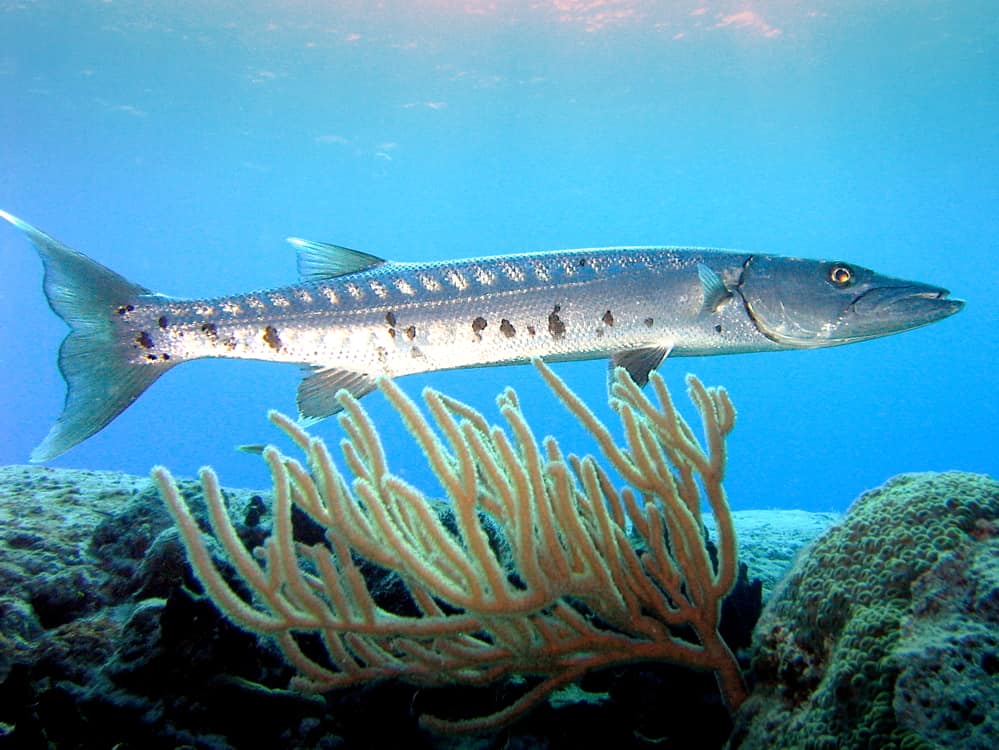
Some say barracudas are more dangerous to people than sharks, but they’re not.
©Laban712 / Public domain, from Wikimedia Commons, the free media repository – License
Some people believe that barracudas are more aggressive than sharks, but they’re not. However, these long, torpedo shaped fish with mouths full of fangs have been known to attack people. As with sharks, a barracuda can mistake a human for prey. Barracudas can grow over 5 feet in length and have little problem attacking other marine animals that are their size or even larger. They even go after dolphins. Barracudas can also attack if they feel frightened or otherwise provoked. They’re also attracted by sudden violent motions such as splashing and bright jewelry.
Barracudas are found in the Atlantic, Pacific, and Indian Oceans, and the Mediterranean Sea. At least one species lives in brackish water. The best practice is to avoid swimming in waters where these dangerous sea creatures live, or swimming amongst them with great care.
7. Lionfish

Lionfish
are beautiful, but they can be deadly.
©bearacreative/Shutterstock.com
These strange, beautiful fish of the Pterois genus live in the Atlantic, Pacific and Indian Oceans and the Caribbean and Mediterranean Seas. They’ve also become invasive off the east coast of the U.S. They have bodies adorned in beautiful black or red bands and long, ornate dorsal fins whose rays deliver venom. Being stung by a lionfish results in terrible pain, nausea and vomiting, temporary paralysis, cardiac failure, convulsions, headache, and anaphylactic shock in people who are sensitive to the venom. Sometimes death occurs, but it’s rare in healthy adults and more common in young children and old people.
8. Sea Snakes
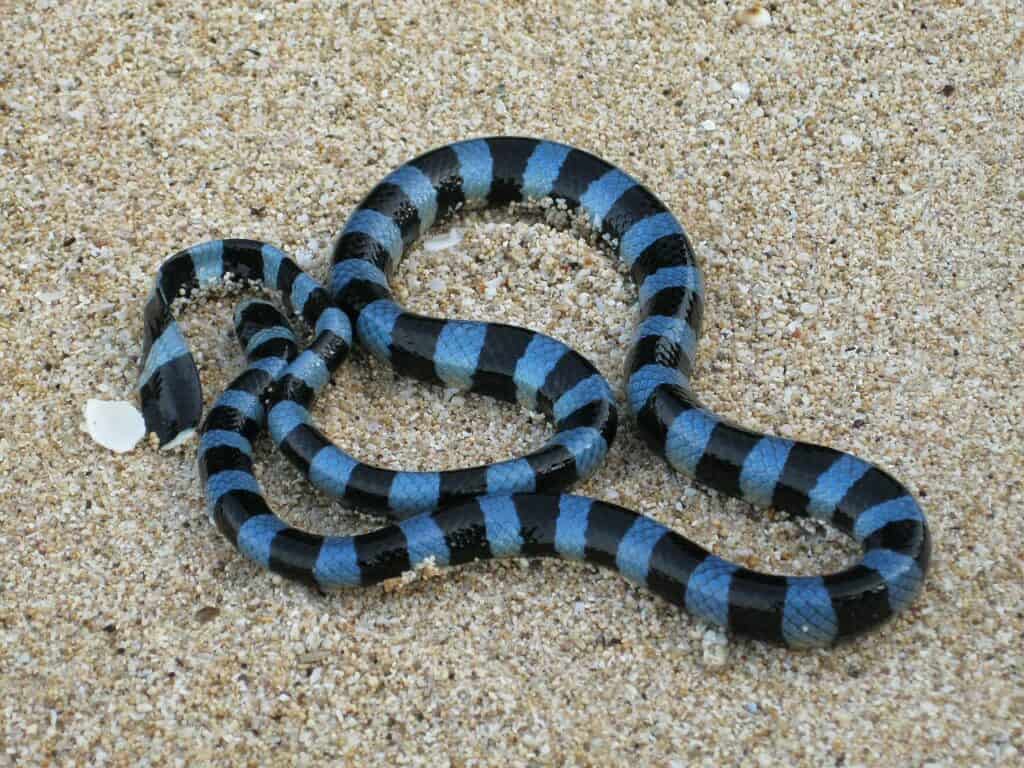
Coral reef snakes rarely bite, but their venom can kill.
©Bramadi Arya / CC BY-SA 4.0 – License
Sea snakes, or coral reef snakes are some of the most dangerous sea creatures. The good news is most rarely bite, and decades can go by between human fatalities. Though these snakes live their lives almost entirely in water and can’t even move on land, they are reptiles that must still breathe air. Like so many other dangerous sea creatures, sea snakes are found off the coast of Australia and in the Indian and Pacific Oceans.
If a sea snake bites you, you might not even feel it. Later, you might discover a wound with the teeth of the snake embedded in it. Soon, you experience headache, sweating, intense thirst, vomiting and a tongue that feels swollen and thick in your mouth. If you’re not treated, you’ll eventually experience drooping eyelids and a breakdown in your voluntary muscles called rhabdomyolysis. This leads to paralysis. If the venom reaches the muscles that help you swallow and breathe, it can kill you.
The photo featured at the top of this post is © Thierry Eidenweil/Shutterstock.com
Thank you for reading! Have some feedback for us? Contact the AZ Animals editorial team.






